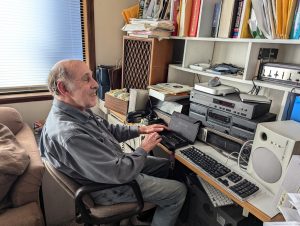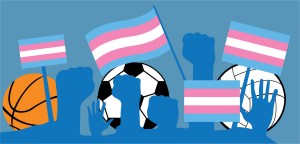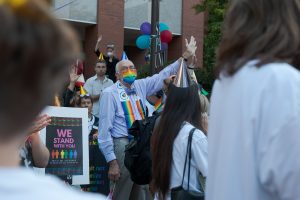Red flags for awareness
Combating domestic and dating violence
November 13, 2019

Red flags dotted the green of Tiffany Loop as Seattle Pacific University’s Office of Safety and Security (OSS) prepared for the annual Red Flag Campaign to raise awareness for domestic and dating violence.
October is nationally recognized as Domestic Violence Awareness Month, and across the country over 400 institutions dawn their own red flags in a solemn salute.
The Red Flag Campaign raised awareness of domestic and dating violence and reminded students of the various resources available to them. “In Their Shoes,” an interactive simulation, also organized by OSS, focused on gaining empathy and understanding for victims and also how to support them.
Through the Red Flag Campaign, OSS hoped not only to bring awareness to the issue of intimate partner violence, but also to empower students to stand up for themselves and give them practical steps to prevent and handle incidents of domestic violence.
On Monday, Oct. 28, security officers and staff set up 500 red flags as symbols of the warning signs in abusive relationships.
Posters around the flags gave examples of what some “red flags” are in a relationship, and encouraged students to say something if they recognize these signs.
“Students and faculty were also invited to participate in this event to both raise awareness and to use as a stepping stone to engage further,” Special Investigations Officer Dido Tzortzi said.
Complimenting the campaign, OSS coordinated a simulation called “In their Shoes.” The simulation gave students and faculty a glimpse into what victims of domestic and dating violence go through.
Communications Officer Julia Zimny was able to gather material for this simulation from the Seattle Police Department Victim Support Team. Her goal was to “put students in the perspective of being the victim without them ever having to be in an abusive relationship themselves.”
The simulation was an interactive experience of going through the cycle of abuse. Participants were given a card with a character and a story. From there they were given slips of paper that allowed them to choose a course of action, for example to go home or to go to a hospital.
This led to different outcomes, and students were presented with the obstacles and difficulties each individual may face. At some stations participants were given a Band-Aid to represent domestic violence and abuse. They then had to choose where to go for help.
“We put on this event to put people in their perspective so they can understand why people go back to abusive relationships and that’s why it’s so hard for them to get out,” Zimny said.
Relational violence affects people regardless of background, but presents itself in different ways.
Tzortzi explained that an undocumented immigrant, for example, does not have the same resources that a U.S. citizen has. They may not be able to go to the police, or the offender may threaten their green card.
By stepping into their shoes, this event brought awareness to the issue on a deeper, more personal level by helping people engage in specific stories.
A debriefing session was held afterward to allow participants to discuss the heavy topics presented. Tea and hot chocolate accompanied the difficult conversations where participants were able to verbally process their experience.
Flyers and pamphlets were also available for participants to get involved in other ways around Seattle and at SPU. These included self-defense programs, volunteer opportunities and an SPU resource guide.
“Students were also encouraged to try a few different stories because there are different challenges and intricacies to peoples’ stories and there are different challenges to accessing resources that you might not know at first glance,” Tzortzi said.
Zimny and Tzortzi spoke about the power dynamics in an unhealthy relationship and how perpetrators exercise control over the victim. While this can look different depending on the circumstances, through the simulation they hoped to inspire awareness and understanding.
According to Zimny, empathy is the key to helping those in dangerous situations, and the way to help them is not by force.
“They’ve had so much power taken away from them, that you want to be the person that gives it back to them,” Zimny said.
“Every time they’re able to make a decision for themselves, they’re able to get that power back for themselves one step at a time.”

























































































